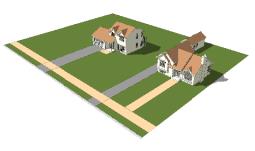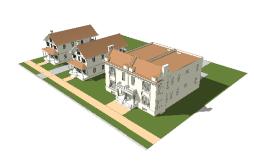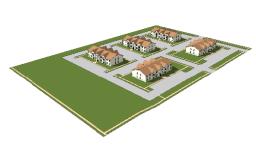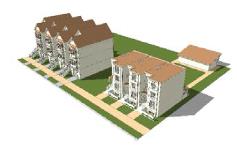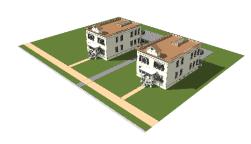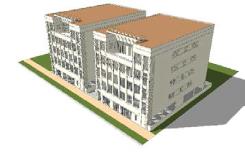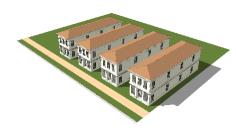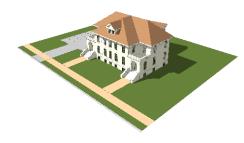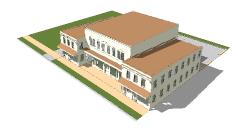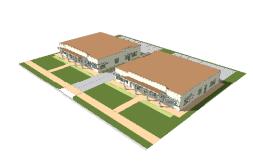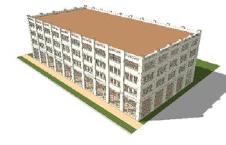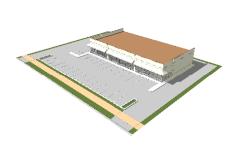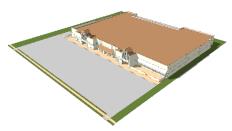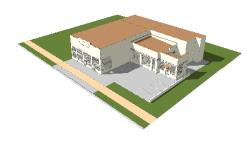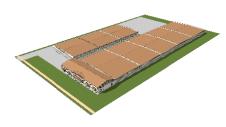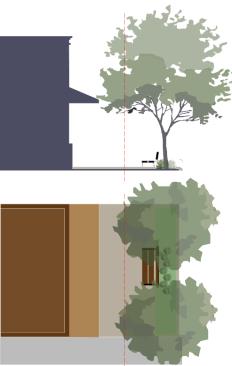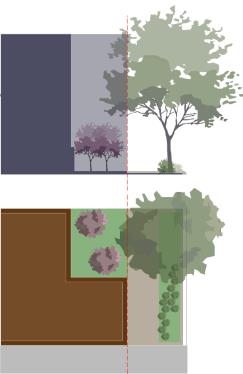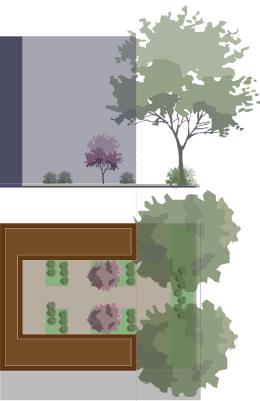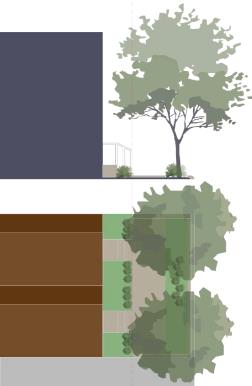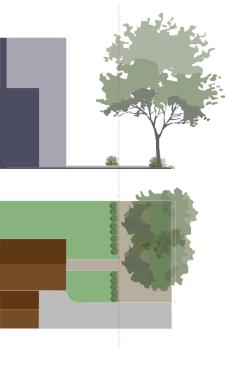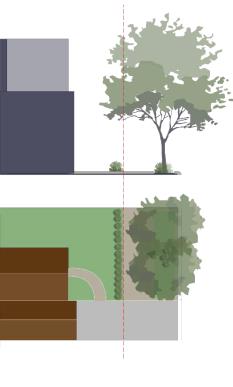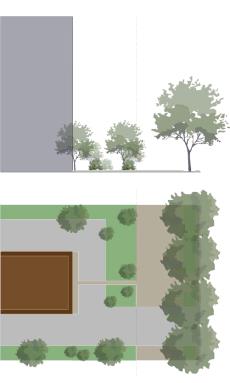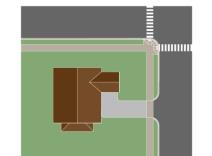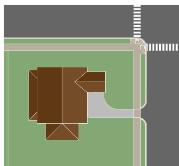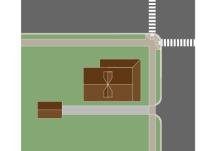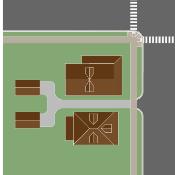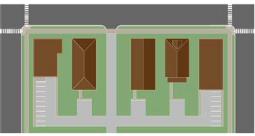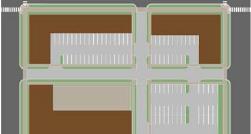Chapter 17.07
BUILDING STANDARDS
Sections:
17.07.010 Intent and Applicability.
17.07.020 Zoning Districts – Building Type and Development Standards.
17.07.030 Building Design Standards.
17.07.040 Specific Building Type Standards.
17.07.010 Intent and Applicability
A. Intent. The intent of this section is to:
1. Implement relationships between private development and the public realm that are appropriate to the context and consistent across multiple buildings and sites.
2. Specify basic building forms and massing, and how different building types relate to streetscapes, blocks, and surrounding development plans to implement the intent of specific zoning districts.
3. Promote high quality design that complements the architecture, landscapes, history and culture in Gardner.
4. Allow unique architectural expression and not exclude any particular architectural style.
5. Reinforce the design principles of scale, proportion, composition, transparency and expression, and particularly how these techniques can allow a wide variety of projects to best complement the broader context.
6. Promote compatibility within zoning districts, and appropriate transitions between different complementary zoning districts, by reducing the emphasis on land use standards and increasing emphasis on scale, form and design standards.
B. Applicability. The building standards apply to all new structures dependent on the appropriate Building Type; provided, however, that communication facilities for wireless services are subject to the application, location, building and design standards of Chapter 17.11 GMC. Specifically, building standards apply to:
1. A newly built structure.
2. Any rehabilitation or expansion of an existing structure that invests more than 50 percent of the appraised value of the structure.
3. Expansion of an existing structure of more than 25 percent of the floor area, but only to the extent of the newly built portion, and only those standards applicable to the expansion.
Building Type standards may be modified for a more specific application to a particular context or plan through the Planned Zoning process in Chapter 17.03 GMC.
C. Building Types. The following Building Type categories have been established to allow a range of building types within districts that are compatible in scale, form and relation to the streetscape.
|
Table 7-1: Building Types |
||
|---|---|---|
|
Detached House A residential building designed for one primary dwelling unit in a neighborhood, suburban or rural setting. Variants of this type are based primarily on lot size and context. |
|
|
|
• |
Detached House – Estate |
|
|
• |
Detached House – Suburban |
|
|
• |
Detached House – Neighborhood |
|
|
• |
Detached House – Compact |
|
|
Duplex A residential building designed to accommodate two primary dwelling units in a neighborhood or suburban setting. Duplex units share a single common wall or floor/ceiling, with an outward design and appearance as a Detached House. A Duplex may be on a single lot, or it may be platted as separate lots along the common wall line subject to platting restrictions. Variants of this type are primarily based on lot size and context. |
|
|
|
• |
Duplex |
|
|
• |
Duplex – Compact |
|
|
Garden Apartment A grouping of small-scale apartment buildings in a common development arranged around an internal system of streets/internal access, walkways and common open space. |
|
|
|
Row House A residential building type designed to accommodate 3 to 8 dwelling units in a compact walkable neighborhood or mixed-use setting. Each unit is separated by a common side wall with a side-by-side configuration, and each has its own private entrance. Units may be on a single lot subject to common ownership restrictions or platted on separate lots along the common wall subject to platting restrictions. |
|
|
|
Walk-Up Apartment A small-scale, multi-unit residential building designed on a small or moderate-sized lot in a compact walkable neighborhood or mixed-use setting. The building is accessed by a common lobby entrance at building frontage, and arranged to integrate into the block structure of a neighborhood. |
|
|
|
Mid-Rise Apartment A moderate-scale, multi-unit residential building on a moderate-sized lot in high-density areas, corridors or mixed-use areas. The building is accessed by a common lobby entrance at the building frontage, and arranged to integrate into the block structure of a neighborhood. |
|
|
|
Live/Work A building designed for a primary dwelling unit but has a secondary component – typically at the building frontage – designed for a commercial and occupational function by the resident. This building type is for transitions between neighborhoods and commercial centers or busier corridors, or for mixed-use areas. |
|
|
|
Civic A building designed for a civic, institutional or public use, with the building and site design that emphasizes the public realm through enhanced design and relationships to streetscape and open space. Variations of this building type include: |
|
|
|
• |
Small Civic |
|
|
• |
Prominent Civic |
|
|
Small Commercial/Storefront A building designed to accommodate small retail, commercial, service or office functions, with frequent pedestrian interaction. The small footprint, small lot, and design of the frontage for pedestrian and customer engagement allows this building type to integrate well in walkable neighborhoods or mixed-use contexts. A variation of this building type is platted with party walls where several small commercial buildings are included in a mixed-use structure. |
|
|
|
Small Commercial/Pad Site A freestanding building similar to a Small Commercial/Storefront, but on a larger lot that includes more space for access, circulation, landscape and buffers. While freestanding, careful planning and site design can allow a series of these buildings to create improved relationships with streetscapes and also become “screens” or “liner buildings” for General Commercial or Large Commercial buildings which are set back from the public realm. |
|
|
|
Mixed-Use A building designed to accommodate ground floor retail or commercial use with frequent pedestrian interaction, and upper level residential, office or commercial uses that support the overall vitality of retail on the site or in the district. This building is typically 2 to 4 stories. |
|
|
|
General Commercial A building type designed to accommodate retail, commercial, service or office functions in a variety of formats and scales. Variations of this type are based on the scale and intensity of the use and subject to lot and setback standards of the zoning district or any specific use limitations for the intended use. |
|
|
|
Large Commercial A building type designed to accommodate large-scale retail, commercial, service or office functions usually in a larger center or complex. Site design, building orientation, and lot access standards specifically arranged to accommodate the patterns and circulation of the complex. |
|
|
|
Small Industrial/Workshop A building designed to accommodate a small light industrial, craft manufacturing or similar commercial use, typically one to two stories. The small footprint, small lot, and the design of the frontage for pedestrian and customer engagement allows this building type to mix well with other commercial uses in a mixed-use context. |
|
|
|
General Industrial A building designed to accommodate light industrial or general industrial functions in a variety of formats. Variations of this type are based on the scale and intensity of the use and subject to lot and setback standards of the zoning district or any specific use limitations for the intended use. |
|
|
(Ord. 2546 § 1; Ord. 2518 § 2 (LDC § 7.01))
17.07.020 Zoning Districts – Building Type and Development Standards
A. Residential Districts. The Development Standards for residential districts shall be based on the different Building Types permitted in each district, as specified in Table 7-2. The Design Standards in GMC 17.07.030 and Specific Building Standards in GMC 17.07.040 may further specify the design and location of each Building Type.
|
Eligible Zoning Districts |
Building Types |
Development Standards |
|||||||||||||
|---|---|---|---|---|---|---|---|---|---|---|---|---|---|---|---|
|
A |
RE |
R-1 |
R-2 |
R-3 |
R-4 |
R-5 |
Lot Standards |
Minimum Setbacks |
Building Height |
||||||
|
Min. Size |
Min. Width |
Building Coverage |
Front |
Interior Side |
Corner Side |
Rear |
|||||||||
|
■ |
■ |
■ |
|
|
|
|
Detached House – Estate |
1 ac./5 ac. |
125'/ 200' A |
10% |
35' |
25' |
25' |
50' |
40' 3 stories |
|
|
|
■ |
■ |
■ |
|
|
Detached House – Suburban |
8K s.f. |
70' |
30% |
25' – 50' |
7' |
20' |
25' |
35' 2.5 stories |
|
|
|
|
■ |
|
■ |
■ |
Detached House – Neighborhood |
6K s.f. |
50' |
40% |
10' – 35' |
5' |
10' |
25' |
35' 2.5 stories |
|
|
|
|
|
|
■ |
■ |
Detached House – Compact |
3.5K – 6K s.f. |
35' |
60% |
10' – 35' |
5' |
10' |
25' |
30' 2 stories |
|
|
|
|
■ |
■ |
■ |
■ |
Duplex |
10K s.f./5K s.f. per unit |
70'/35' per unit |
30% |
25' – 50' |
7'/0' party wall |
20' |
25' |
35' 2.5 stories |
|
|
|
|
|
|
■ |
■ |
Duplex – Compact |
6K – 10K s.f./3K s.f. per unit |
50'/25' per unit |
60% |
10' – 35' |
5'/0' party wall |
10' |
25' |
35' 2.5 stories |
|
|
|
|
|
■ |
■ |
■ |
Row House |
2K – 4.5K s.f. per unit |
18' – 36' per unit |
70% |
10' – 25' |
5'/0' party wall |
10' |
20' |
40' 3 stories |
|
|
|
|
|
|
■ |
■ |
Walk-Up Apartment |
6K – 10K s.f. |
50' – 100' |
70% |
10' – 25' |
5'/10'* |
10' |
20' |
40' 3 stories |
|
|
|
|
|
|
|
■ |
Mid-Rise Apartment |
10K – 20K s.f. |
80' – 200' |
70% |
10' – 25' |
5'/10'* |
10' |
20' |
60' 5 stories |
|
|
|
|
|
■ |
|
|
Garden Apartment |
10K s.f./1.5K s.f. per unit |
70' |
40% |
25' – 50' |
7' |
20' |
25' |
40' 3 stories |
|
|
|
|
|
|
■ |
■ |
Live/Work |
See Nonresidential Building Types in Table 7-3 |
|||||||
|
■ |
■ |
■ |
■ |
■ |
■ |
■ |
Small Civic |
See Nonresidential Building Types in Table 7-3 |
|||||||
|
|
|
|
|
|
■ |
■ |
Prominent Civic |
See Nonresidential Building Types in Table 7-3 |
|||||||
|
■ |
|
|
|
|
|
|
General Industrial |
See Nonresidential Building Types in Table 7-3 |
|||||||
*See Building Type standards in GMC 17.07.040 for applicable specifications.
B. Nonresidential Districts. The Development Standards for nonresidential districts shall be based on the different Building Types permitted in each district, as specified in Table 7-3. The Design Standards in GMC 17.07.030 and Specific Building Standards in GMC 17.07.040 may further specify the design and location of each Building Type.
|
Eligible Zoning Districts |
Building Types |
Development Standards |
||||||||||||||
|---|---|---|---|---|---|---|---|---|---|---|---|---|---|---|---|---|
|
C-O |
CO-A |
C-1 |
C-2 |
C-3 |
M-1 |
M-2 |
REC |
Lot Standards |
Setbacks |
Building Height |
||||||
|
Min. Size |
Min. Width |
Max. Coverage |
Front |
Interior Side |
Corner Side |
Rear |
||||||||||
|
■ |
■ |
■ |
|
|
|
|
|
Live/Work |
2K – 4.5K s.f. |
18' – 50' |
80% |
0' – 25' |
5'/0' if party wall |
10' |
20' |
45' 3 stories |
|
■ |
■ |
■ |
■ |
■ |
|
|
|
Small Commercial/ |
2K – 10K s.f. |
25' – 100' |
90% |
0' – 10' |
5'/0' if party wall |
10' |
20' min./ 10' if alley* |
45' 3 stories |
|
■ |
■ |
■ |
■ |
■ |
■ |
■ |
■ |
Small Commercial/ |
6K s.f. |
50' |
50% |
25' |
10' |
25' |
25' |
35' 2 stories |
|
■ |
■ |
■ |
■ |
|
|
|
|
Mixed-Use |
2.5 – 30K s.f. |
25' – 200' |
90% |
0' – 10' |
5'/0' if party wall |
0' – 10'* |
20' min./ 10' if alley* |
65' 5 stories |
|
|
|
|
■ |
■ |
■ |
■ |
|
General Commercial |
10K – 50K s.f. |
100' |
50% |
25' |
10'/25' res.* |
25' |
25' |
35' 2 stories |
|
|
|
|
■ |
■ |
■ |
■ |
|
Large Commercial |
50K s.f. |
200' |
50% |
25' |
25' |
25' |
25' |
65' 5 stories |
|
■ |
■ |
■ |
■ |
■ |
■ |
|
■ |
Small Civic |
5K s.f. – 2.5 ac. |
50' – 300' |
50% |
20' – 50' |
25' |
25' |
25' |
35' 2 stories |
|
■ |
|
■ |
■ |
■ |
■ |
|
■ |
Prominent Civic |
2.5 – 5 acres |
150' |
50% |
20' – 50' |
25' |
25' |
25' |
55' 4 stories |
|
■ |
■ |
■ |
■ |
■ |
■ |
■ |
|
Small Industrial/ |
2K – 10K s.f. |
40' |
70% |
0' – 25' |
5'/15' res.* |
10' |
25'/10' if alley* |
35' 2 stories |
|
|
|
|
|
■ |
■ |
■ |
|
General Industrial |
10K s.f. |
100' |
50% |
50' |
10'/50' res.* |
20'/50' res.* |
15'/50' res.* |
75'/50' res.* |
|
■ |
■ |
■ |
|
|
|
|
|
Row House |
See Residential Building Types in Table 7-2 |
|||||||
|
■ |
■ |
■ |
|
|
|
|
|
Apartment – Walk-Up |
See Residential Building Types in Table 7-2 |
|||||||
*See Building Type standards in GMC 17.07.040 for applicable specifications.
(Ord. 2584 § 1; Ord. 2550 § 1; Ord. 2533 § 1; Ord. 2518 § 2 (LDC § 7.02))
17.07.030 Building Design Standards
A. Design Objectives. The objectives of the Building Design Standards are to:
1. Promote diverse yet harmonious design, encourage unique architectural expression, and establish basic criteria for promoting a variety of building types in a compatible and supporting context.
2. Relate buildings to public realm and streetscape; create a consistent street wall along the block face and create a rhythm of mass to voids along the block.
3. Relate buildings to adjacent property; mimic similar scale, massing and proportions of adjacent development, particularly nearest the lot boundaries, through step-backs and secondary masses that reduce the volume in one area and create scale transitions between adjacent buildings.
4. Promote human-scale design; arrange buildings in a way that creates meaningful outdoor spaces on the site with building designs that relate to and activate these spaces.
5. Promote enduring investments; use basic principles of architectural design and apply durable, quality materials so that buildings last generations.
B. Massing. Building massing refers to how the form, scale and proportions of buildings shape spaces around the buildings, including streetscapes, civic spaces and other unbuilt portions of lots.
1. Required Building Frontage. Specific Frontage Types in GMC 17.07.050 include a required building frontage to create a consistent relationship and rhythm of buildings along a block face. When a “required building frontage” is established as a percentage, that shall be the minimum percentage of the lot frontage that shall be occupied by the principal structure at the front building line. An exception may be granted for up to 50 percent of this requirement through the administrative adjustment process, provided:
a. The site provides active pedestrian space comparable to the Open and Civic Space System; and
b. A vertical element such as a low hedge, ornamental wall, or fence complementing the design and materials of the building is substituted as an extension of the building line.
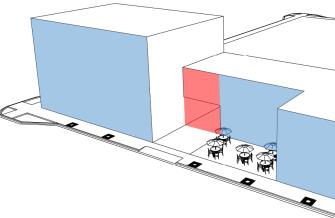
Figure 7-1 Required Building Frontage
A building’s front setback can vary if the additional setback adds public space or vertical elements are added as substitute for the building (shown in blue). Items such as a drive do not count as building frontage (shown in red).
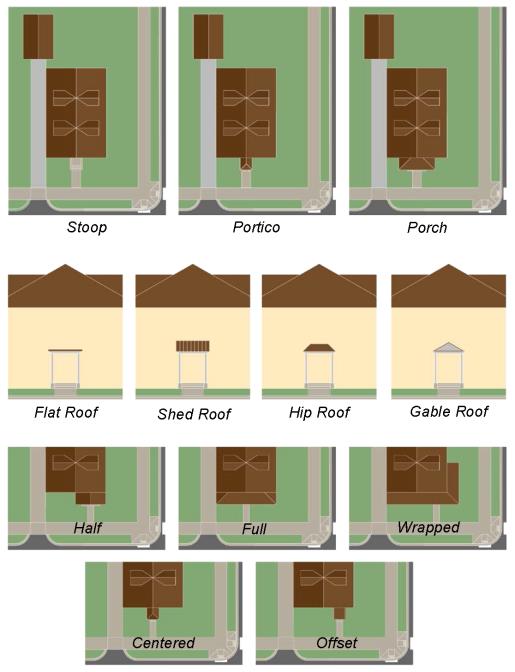
Figure 7-2 Primary Entry Feature
Options for primary entry features help avoid repetition of facade design along a streetscape and allow consistent, human-scale relationships between buildings and streetscapes. A number of options are available beyond what is displayed in the graphic.
2. Primary Entry Features. Front entry features create a human-scale relationship of buildings to the street. They provide opportunities for subtle variations in design on the streetscape and can help create compatible relationships between buildings of different size.
a. Residential buildings should have one of the following single-story front entry features on the front facade:
(1) An unenclosed porch at least eight feet deep and covering at least 50 percent of the front facade.
(2) An unenclosed stoop that is at least eight feet by eight feet and includes ornamental features to accent the door, such as a canopy, transom windows, enhanced trim and molding or other similar accents.
(3) An enclosed portico that is integrated with the materials and architecture of the building, but no more than 100 square feet.
(4) Single-story front entrance features meeting this requirement may encroach up to 10 feet in front of the required front building line.
(5) Where more than one dwelling unit is constructed along a block face, variations in the front entry features shall create diversity among buildings. Variations may include any combination of:
(a) Different types: such as stoop, porch or portico;
(b) Different roof styles: such as gable, hip, shed, flat or arched;
(c) Different locations and extent: such as centered, shifted, wrapped; and half or full.
Subtle differences in these details can create extensive diversity, while simultaneously creating great compatibility through the similar scale and orientation of the features.
b. Nonresidential buildings should have each primary public entrance clearly defined and highly visible with at least three of the following elements:
(1) Awnings, porticos, or overhangs.
(2) Recesses/projections.
(3) Arches or arcades.
(4) Raised parapets or gables.
(5) Transoms and/or display windows.
(6) Architectural details such as tile work and moldings.
(7) Change in color or building materials.
(8) Statues, fountains, freestanding columns, or public art.
(9) Integral planters or wing walls that incorporate landscaping and/or places for sitting.
(10) Trees or shrubs.
3. Garage Limits. Certain building types, due to their close relationship to the streetscape and/or narrow lots with frequent repetition along a block, should limit front-loaded garage access. Limits are expressed as a maximum width of the front facade at the front building line, or a limit that may be shifted back from this line to reduce the impact. When front-loaded garages cannot work within these standards, side, rear, or rear-access garages should be used.

Figure 7-3 Garage Limits
For building types with limits on garage widths, different options for extent, location and orientation of garages may be necessary.
4. Massing Generally. All massing of buildings should create meaningful and human-scale outdoor spaces on the site and relate the design of the buildings and facades to these spaces. Avoid contrived massing that simply calls attention to the structure or attempts to make monumental or elaborate design out of simple structures.
a. Use structural bays, projections, balconies, cantilevered floors or stepbacks from the main mass to break up larger wall planes and relate the building scale to nearby buildings.
b. Buildings greater than three stories or wider than 100 feet should use massing that breaks down the components of the main mass.
c. No single wall plane should be longer than 100 feet without having offsets of at least one foot to add depth and proportion to the wall.
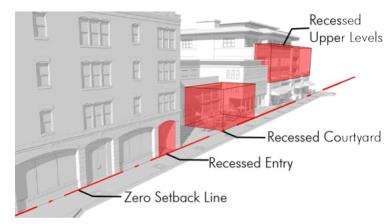
Figure 7-4 Building Massing
Creating outdoor spaces relating them to the public realm without creating monumental or elaborate designs calling attention to the building.
C. Facade Composition. Facade composition refers to the use of materials, fenestration and architectural details and ornamentation to add interest and uniqueness to buildings, and activate or emphasize certain spaces around a building.
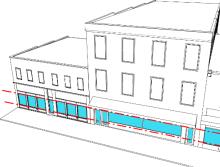
Figure 7-5 First Floor Transparency
Creating transparency along the first floor to establish a visible connection with the pedestrian.
1. Transparency. The location, orientation, size and proportion of openings establish a relationship of the building to the public realm. Certain building types have transparency percentages that specify the percent of opening per building type:
a. Where expressed as a street level requirement the percentage shall be measured between two feet and eight feet above the street level.
b. Where expressed as an upper level requirement or to facades generally, the percentage shall be measured between the floor level and ceiling of each story.
c. All ground level windows required for nonresidential buildings shall provide direct views to the building’s interior or to a lit display area extending a minimum of three feet behind the window.
d. The location and orientation of windows and doors should be proportionate to different massing elements of the building and help create rhythm and symmetry within each element.
2. Articulation. Articulation is the method of styling different parts of a building in the way that breaks the scale into smaller elements, but unites the building into a complete and compatible mass.
a. Horizontal articulation should establish a base, body and top of all buildings.
(1) For buildings three stories or less, this can be a distinct foundation, main facade, and an embellished roof structure, such as eaves and fascia for pitched roofs, or cornices and parapets for flat roofs.
(2) For buildings three stories or more, the first floor should be clearly differentiated from upper stories to establish the base.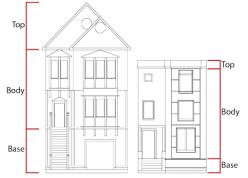
Figure 7-6 Horizontal Articulation
Showing the base, body and top of a building creates scale and breaks down large facades.
b. Vertical articulation shall distinguish different structural components of the building through changes in material and/or color.
c. Where materials are stacked (i.e., one above another), the transition between materials should include a sill, cap, frame, roof (if at ceiling height), or similar element to separate the two materials.
d. Where materials are side-by-side, the transition between materials should occur at interior corners or at the trim line where the change is emphasizing different structural bays for a building.
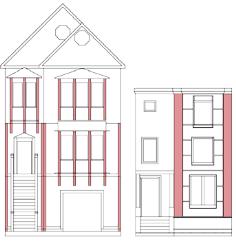
Figure 7-7 Vertical Articulation
Visual bays or structural components draw the eye along the facade. This breaks up buildings mass creating a rhythm between repeated facades.
3. Ornamentation. Any other blank wall areas larger than eight feet tall by 25 feet wide should be broken up by ornamental architectural details, unless the blank surface area is less than 10 percent of the total facade area and the longest dimension of the blank surface area is less than 50 feet.
D. Materials. Selection and application of materials add depth, texture, and color to the composition of walls. Design and detailing of materials should create an integrated relationship between different architectural elements of buildings, complement context, and signify enduring investment in the community.
1. Primary Materials. The predominant surfaces on building walls shall incorporate one or more of the following building materials:
a. Brick;
b. Stone;
c. Cast stone;
d. Synthetic stone;
e. Stucco;
f. Water-managed EIFS;
g. Prefinished noncorrugated metal (nonresidential only);
h. Glass;
i. Buildings greater than or equal to 20,000 square feet may use:
(1) Integral-color concrete masonry units;
(2) Concrete (precast or formed, excluding CMU);
j. Buildings under 20,000 square feet may use:
(1) Wood siding (excluding plywood sheet siding);
(2) Fiber-cement siding;
(3) Synthetic wood siding;
(4) Split shakes;
(5) Vinyl siding (residential only).
2. Prohibited Building Materials. Predominant surfaces on building walls shall not include any of the following building materials:
a. Plywood sheet siding;
b. Barrier-type EIFS;
c. Painted CMU;
d. Corrugated metal;
e. Painted metal;
f. Wood shakes are prohibited as roofing materials.
3. Awnings. Awnings shall be constructed of fabric, metal or glass. Plastic awnings are prohibited.
4. Color.
a. For all building types, primary facade colors shall be low-reflecting and subtle. Intense, bright, or fluorescent colors are prohibited as primary facade colors. For new detached house and duplex building types, a color palette shall be submitted before issuance of a certificate of occupancy. For all other new building types, a color palette shall be approved per subsection (D)(4)(b) of this section.
b. For all building types except detached houses or duplexes, a color palette shall be provided with all site plan, final development plan, and building permit applications. No building permit shall be issued until a color palette has been approved by the Planning Commission or Director.
(1) The color palette shall include all primary and accent colors that will be used throughout the development, including roofs and awnings. The number of colors is not limited, provided that all of the proposed colors are part of a coordinated color scheme.
(2) Color palettes shall tie building elements together, relate separate (freestanding) buildings within the same development, and enhance the architectural form of a building.
(3) All building accessories, including, but not limited to, meters, flues, vents, gutters, and utilities shall match or complement in color the permanent color of the surface from which they project. (Ord. 2533 § 1; Ord. 2518 § 2 (LDC § 7.03))
17.07.040 Specific Building Type Standards
The following building type standards are specific to each Building Type enabled within any zoning district (see GMC 17.07.020).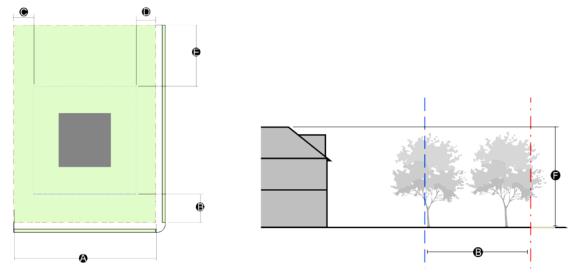
|
Detached House – Estate |
||
|---|---|---|
|
|
Lot Size |
|
|
A |
Width |
125' min. |
|
|
Area |
1 acre min. |
|
|
Building Placement |
|
|
B |
Front |
35' min. |
|
C |
Side |
25' min. |
|
D |
Corner Side |
25' min. |
|
E |
Rear |
50' min. |
|
|
Building Scale and Mass |
|
|
F |
Height |
40' max./3 stories |
|
|
Frontage Type |
Suburban Yard; Neighborhood Yard |
|
|
Building Coverage |
10% max. |
|
|
Design and Performance Standards |
|
|
|
In the A district no lot shall be platted that is less than 5 acres and less than 200' wide. |
|
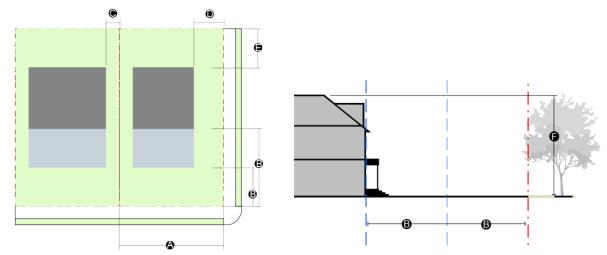
|
Detached House – Suburban |
||
|---|---|---|
|
|
Lot Size |
|
|
A |
Width |
70' min. |
|
|
Area |
8,000 s.f. min. |
|
|
Building Placement |
|
|
B |
Front |
25' – 50' |
|
C |
Side |
7' min. |
|
D |
Corner Side |
20' min. |
|
E |
Rear |
25' min. |
|
|
Building Scale and Mass |
|
|
F |
Height |
35' max./2.5 stories |
|
|
Frontage Type |
Suburban Yard; Neighborhood Yard |
|
|
Building Coverage |
30% max. |
|
|
Design and Performance Standards |
|
|
|
None |
|
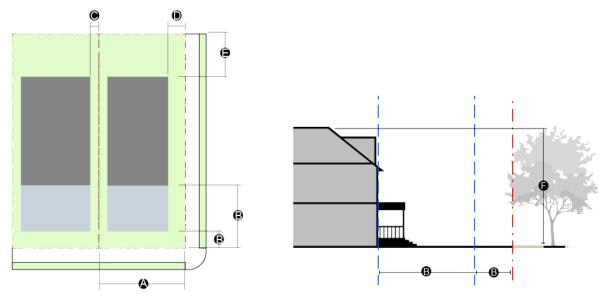
|
Detached House – Neighborhood |
||
|---|---|---|
|
|
Lot Size |
|
|
A |
Width |
50' min. |
|
|
Area |
6,000 s.f. min. |
|
|
Building Placement |
|
|
B |
Front |
10' – 35' |
|
C |
Side |
5' min. |
|
D |
Corner Side |
10' min. |
|
E |
Rear |
25' min. |
|
|
Building Scale and Mass |
|
|
F |
Height |
35' max./2.5 stories |
|
|
Frontage Type |
Neighborhood Yard; |
|
|
Building Coverage |
40% max. |
|
|
Design and Performance Standards |
|
|
|
Garage Limits = 25% of facade if front-loaded; up to 45% if set back 15'+ from front building line; no limits if side-loaded, rear or detached. |
|
|
|
Single-story front entry feature required. |
|
|
|
Terrace frontage types (10' – 25') are limited only to lots fronting on Neighborhood street types. |
|
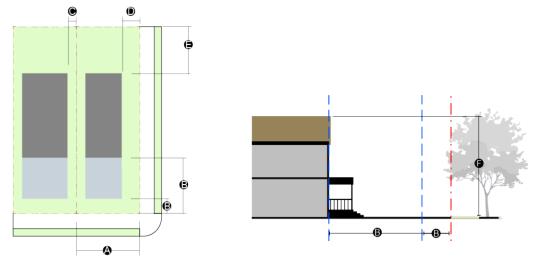
|
Detached House – Compact |
||
|---|---|---|
|
|
Lot Size |
|
|
A |
Width |
35' min. |
|
|
Area |
3,500 s.f. – 6,000 s.f. |
|
|
Building Placement |
|
|
B |
Front |
10' – 35' |
|
C |
Side |
5' min. |
|
D |
Corner Side |
10' min. |
|
E |
Rear |
25' min. |
|
|
Building Scale and Mass |
|
|
F |
Height |
30' max./2 stories |
|
|
Frontage Type |
Neighborhood Yard; Terrace (limited); Courtyard (limited) |
|
|
Building Coverage |
60% max. |
|
|
Design and Performance Standards |
|
|
|
Garage Limits = front-loaded prohibited; side-loaded, rear or detached required. |
|
|
|
Single-story front entry feature required. |
|
|
|
Terrace frontage types (10' – 25') are limited only to lots fronting on Neighborhood street types. |
|
|
|
Detached Houses – Compact may be arranged with a Courtyard frontage type on Neighborhood street types with up to 8 units on a lot, provided the lot size shall be at least 0.75 times the lot size required for each unit. All setbacks shall be met on the external lot perimeter, except that the front setback may be reduced to 10'. |
|
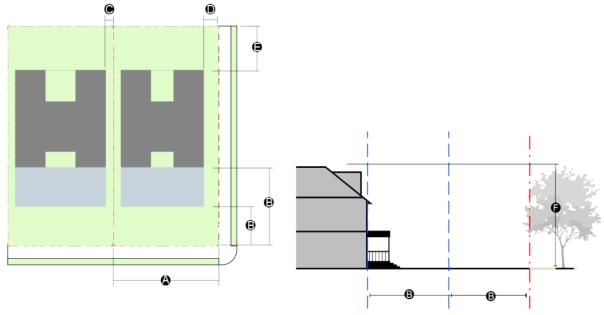
|
Duplex |
||
|---|---|---|
|
|
Lot Size |
|
|
A |
Width |
70' min./35' per unit |
|
|
Area |
10,000 s.f. min./5,000 s.f. min. per unit |
|
|
Building Placement |
|
|
B |
Front |
25' – 50' |
|
C |
Side |
7' min.; 0' if units platted with party wall |
|
D |
Corner Side |
20' min. |
|
E |
Rear |
25' min. |
|
|
Building Scale and Mass |
|
|
F |
Height |
35' max./2.5 stories |
|
|
Frontage Type |
Neighborhood Yard; Suburban Yard |
|
|
Building Coverage |
30% max. |
|
|
Design and Performance Standards |
|
|
|
Garage Limits = 25% of facade if front-loaded; up to 45% if set back 15'+ from front building line; no limits if side, rear or detached. |
|
|
|
Single-story front entry feature required. |
|
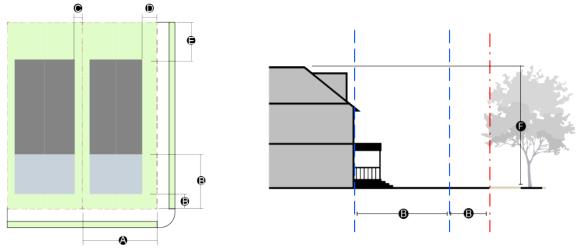
|
Duplex – Compact |
||
|---|---|---|
|
|
Lot Size |
|
|
A |
Width |
50' min./25' min. per unit if platted with party wall |
|
|
Area |
6,000 s.f. – 10,000 s.f./3,000 s.f. min. per unit if platted with party wall |
|
|
Building Placement |
|
|
B |
Front |
10' – 35' |
|
C |
Side |
5' min./0' if units platted with party wall |
|
D |
Corner Side |
10' min. |
|
E |
Rear |
25' min. |
|
|
Building Scale and Mass |
|
|
F |
Height |
35' max./2.5 stories |
|
|
Frontage Type |
Neighborhood Yard; Terrace (limited); Courtyard (limited) |
|
|
Building Coverage |
60% max. |
|
|
Design and Performance Standards |
|
|
|
Garage Limits = 25% of facade if front-loaded; up to 45% if set back 15'+ from front building line; no limits if side, rear or detached. |
|
|
|
Single-story front entry feature required. |
|
|
|
Terrace frontage types (10' – 25') are limited only to lots fronting on Neighborhood street types. |
|
|
|
Duplexes – Compact may be arranged with a Courtyard frontage type on Neighborhood street types with up to 6 buildings (12 units) on a lot, provided the lot size shall be at least 0.75 times the lot size required for each unit. All setbacks shall be met on the external lot perimeter, except that the front setback may be reduced to 10'. |
|
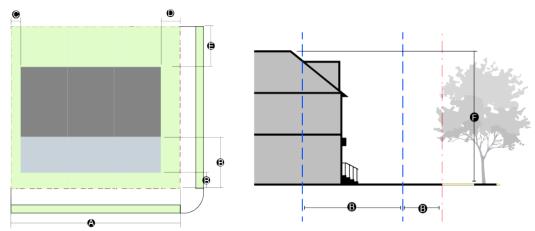
|
Row House |
||
|---|---|---|
|
|
Lot Size |
|
|
A |
Width |
18' – 36' per unit |
|
|
Area |
2,000 s.f. – 4,500 s.f. per unit |
|
|
Building Placement |
|
|
B |
Front |
10' – 25' |
|
C |
Side |
5' min./0' if units platted with party wall |
|
D |
Corner Side |
10' min. |
|
E |
Rear |
20' min. |
|
|
Building Scale and Mass |
|
|
F |
Height |
40' max./3 stories |
|
|
Frontage Type |
Terrace; Courtyard (limited); Buffer Edge (limited) |
|
|
Building Coverage |
70% max. |
|
|
Design and Performance Standards |
|
|
|
No more than 8 lots/units may be attached without a minimum 12' separation between adjacent buildings. |
|
|
|
Garage Limits = Any attached garage entry shall be limited to a side or rear facade, except in the R-3 district. |
|
|
|
Single-story front entry feature required. |
|
|
|
Row Houses may be arranged with a Courtyard frontage type on Neighborhood street types with up to 3 buildings or 18 units on a lot, provided the lot size shall be at least 0.75 times the lot size required for each unit. All setbacks shall be met on the external lot perimeter. |
|
|
|
The Buffer Edge frontage type shall only be used in the R-3 district. |
|
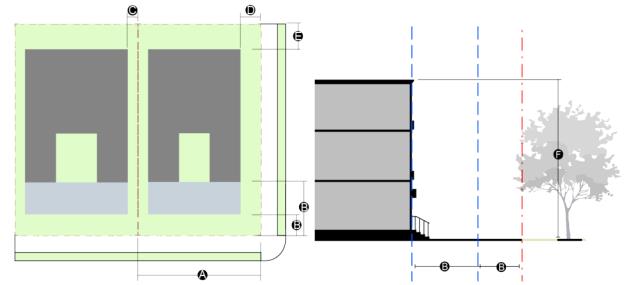
|
Apartment – Walk-Up |
||
|---|---|---|
|
|
Lot Size |
|
|
A |
Width |
50' – 100' |
|
|
Area |
6,000 s.f. – 10,000 s.f. |
|
|
Building Placement |
|
|
B |
Front |
10' – 25' |
|
C |
Side |
5' min./10' min. if adjacent to Detached House |
|
D |
Corner Side |
10' min. |
|
E |
Rear |
20' min. |
|
|
Building Scale and Mass |
|
|
F |
Height |
40' max./3 stories |
|
|
Frontage Type |
Terrace; Courtyard (limited) |
|
|
Building Coverage |
70% max. |
|
|
Design and Performance Standards |
|
|
|
Buildings may include 3 to 12 units. |
|
|
|
Garage Limits = Any attached garage entry shall be limited to a side or rear facade. |
|
|
|
Single-story front entry feature required. |
|
|
|
Walk-Up Apartments may be arranged with a Courtyard frontage type on Neighborhood or Activity street types with up to 6 buildings or 36 units (whichever is less) on a lot, provided the lot size shall be at least 0.75 times the lot size required for each building, and all setbacks shall be met on the external lot only. |
|
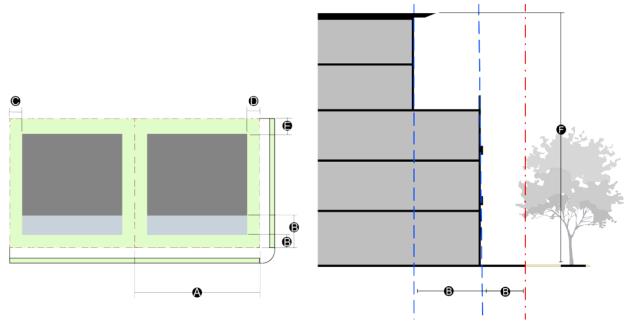
|
Apartment – Mid-Rise |
||
|---|---|---|
|
|
Lot Size |
|
|
A |
Width |
80' – 200' |
|
|
Area |
10,000 s.f. – 20,000 s.f. |
|
|
Building Placement |
|
|
B |
Front |
10' – 25' |
|
C |
Side |
5' min./10' min. if adjacent to Detached House |
|
D |
Corner Side |
10' min. |
|
E |
Rear |
20' min. |
|
|
Building Scale and Mass |
|
|
F |
Height |
60' max./5 stories |
|
|
Frontage Type |
Terrace; Courtyard |
|
|
Building Coverage |
70% max. |
|
|
Design and Performance Standards |
|
|
|
Buildings may include up to 40 units. |
|
|
|
Garage Limits = Any attached garage entry shall be limited to a side or rear facade. |
|
|
|
Single-story front entry feature required. |
|
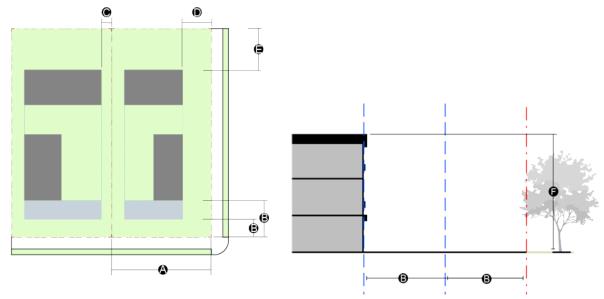
|
Apartment – Garden |
||
|---|---|---|
|
|
Lot Size |
|
|
A |
Width |
70' min. |
|
|
Area |
10,000 s.f. min./1,500 s.f. min. per unit |
|
|
Building Placement |
|
|
B |
Front |
25' – 50' |
|
C |
Side |
7' min. |
|
D |
Corner Side |
20' min. |
|
E |
Rear |
25' min. |
|
|
Building Scale and Mass |
|
|
F |
Height |
40' max./3 stories |
|
|
Frontage Type |
Terrace; Buffer Edge |
|
|
Building Coverage |
40% max. |
|
|
Design and Performance Standards |
|
|
|
Minimum separation of at least 20' between all buildings. |
|
|
|
Minimum 40% developed as open space; and a minimum 10% developed as active open space. |
|
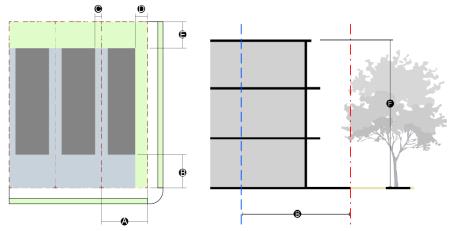
|
Live/Work |
||
|---|---|---|
|
|
Lot Size |
|
|
A |
Width |
18' – 50' |
|
|
Area |
2,000 s.f. – 4,500 s.f. |
|
|
Building Placement |
|
|
B |
Front |
0' – 25' |
|
C |
Side |
5' min./0' if units platted with party wall |
|
D |
Corner Side |
10' min. |
|
E |
Rear |
20' min. |
|
|
Building Scale and Mass |
|
|
F |
Height |
45' max./3 stories |
|
|
Frontage Type |
Terrace; Courtyard; Enhanced Streetscape |
|
|
Building Coverage |
80% max. |
|
|
Design and Performance Standards |
|
|
|
0' – 10' front setback with an Enhanced Streetscape frontage type on a designated Activity street type or in the C-1 district; 10' – 25' front setback with Terrace or Courtyard frontage type permitted in all other cases. |
|
|
|
75% minimum front building line. |
|
|
|
Transparency = 40% – 80% at street level; 15% – 40% on upper levels. |
|
|
|
Primary Entrance Feature = 1 per building frontage. |
|
|
|
Access Limits = 15% of lot frontage in front of rear building line. |
|
|
|
Parking for Live/Work buildings in residential neighborhoods shall be limited to no more than 4 spaces per site and/or on-street parking; any on-site parking shall be set back at least 30' from the lot frontage and at least 10' from side or rear property lines. |
|
|
|
In the R-4 or R-5 district, Live/Work buildings shall be limited to corner lots on a collector street or higher, or fronting on arterial streets. |
|
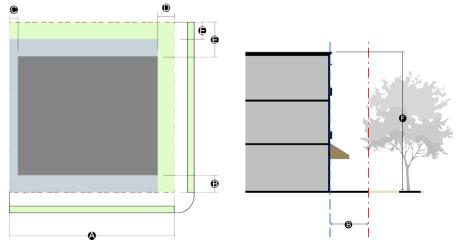
|
Small Commercial/Storefront |
||
|---|---|---|
|
|
Lot Size |
|
|
A |
Width |
25' – 100' |
|
|
Area |
2,000 s.f. – 10,000 s.f. |
|
|
Building Placement |
|
|
B |
Front |
0' – 10' |
|
C |
Side |
5' min./0' if units platted with party wall |
|
D |
Corner Side |
10' min. |
|
E |
Rear |
20' min./10' min. for alley-loaded lots |
|
|
Building Scale and Mass |
|
|
F |
Height |
45' max./3 stories |
|
|
Frontage Type |
Terrace; Plaza; Enhanced Streetscape |
|
|
Building Coverage |
90% max. |
|
|
Design and Performance Standards |
|
|
|
Corner side setbacks may be reduced to the same as front when the building design and frontage type continues for at least the first 30' of building frontage on the side street. |
|
|
|
Transparency = 50% – 80% at street level; 20% – 50% on upper story. |
|
|
|
Primary Entrance Feature = 1 per building frontage; 1 per 50' on Activity streets. |
|
|
|
No off-street surface parking shall be located in front of the front building line; any parking to the side shall be limited to no more than 30% of the lot frontage and screened at the front building line; all other parking shall be located behind the building or otherwise set back from the street at least 30'. |
|
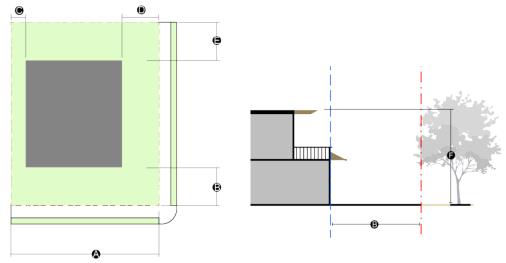
|
Small Commercial/Pad Site |
||
|---|---|---|
|
|
Lot Size |
|
|
A |
Width |
50' min. |
|
|
Area |
6,000 s.f. min. |
|
|
Building Placement |
|
|
B |
Front |
25' min. |
|
C |
Side |
10' min. |
|
D |
Corner Side |
25' min. |
|
E |
Rear |
25' min. |
|
|
Building Scale and Mass |
|
|
F |
Height |
35' max./2 stories |
|
|
Frontage Type |
Buffer Edge; Enhanced Streetscape; Plaza; Terrace |
|
|
Building Coverage |
50% max. |
|
|
Design and Performance Standards |
|
|
|
The front setback may be reduced below 25' when designed with an Enhanced Streetscape, Plaza or Terrace frontage type. |
|
|
|
0' – 25' front setback with Enhanced Streetscape, Plaza or Terrace frontage type required in the C-1 district. |
|
|
|
Enhanced Streetscape or Terrace frontage type required on Activity streets. |
|
|
|
Transparency = 50% – 80% at street level; 30% – 50% on upper story. |
|
|
|
Primary Entrance Feature = 1 per building frontage on Activity streets; side entrances may be permitted on other street types provided there is a direct pedestrian connection to the entrance from the street frontage. |
|
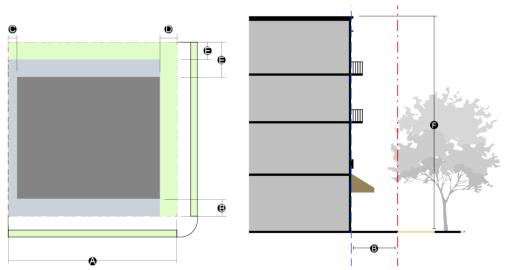
|
Mixed-Use |
||
|---|---|---|
|
|
Lot Size |
|
|
A |
Width |
25' – 200' |
|
|
Area |
2,500 s.f. – 30,000 s.f. |
|
|
Building Placement |
|
|
B |
Front |
0' – 10' |
|
C |
Side |
5' min./0' if units platted with party wall |
|
D |
Corner Side |
10' min. |
|
E |
Rear |
20' min./10' min. for alley-loaded lots |
|
|
Building Scale and Mass |
|
|
F |
Height |
65' max./5 stories |
|
|
Frontage Type |
Enhanced Streetscape; Plaza; Courtyard; Terrace |
|
|
Building Coverage |
90% max. |
|
|
Design and Performance Standards |
|
|
|
Corner side setbacks may be reduced to the same as front when the building design and frontage type continues for at least the first 30' of building frontage on the side street. |
|
|
|
Transparency = 50% – 80% at street level; 30% – 50% on upper story. |
|
|
|
Primary Entrance Feature = 1 per 75' of building frontage; 1 per 50' on Activity streets. |
|
|
|
Parking shall be designed so as to minimize the visual appearance of the parking area to the public right-of-way and shall meet the minimum standards of Chapter 17.09 GMC. |
|
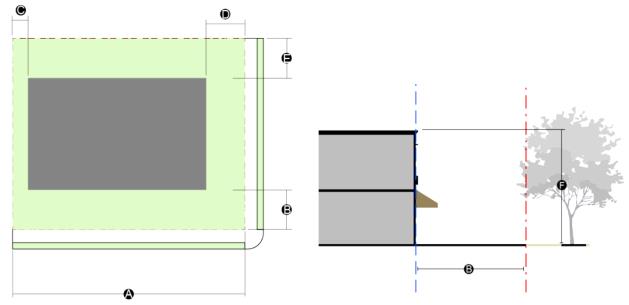
|
General Commercial |
||
|---|---|---|
|
|
Lot Size |
|
|
A |
Width |
100' min. |
|
|
Area |
10,000 s.f. – 50,000 s.f. |
|
|
Building Placement |
|
|
B |
Front |
25' min. |
|
C |
Side |
10' min./25' min. if adjacent to residentially zoned parcels |
|
D |
Corner Side |
25' min. |
|
E |
Rear |
25' min. |
|
|
Building Scale and Mass |
|
|
F |
Height |
35' max./2 stories |
|
|
Frontage Type |
Buffer Edge; Terrace |
|
|
Building Coverage |
50% max. |
|
|
Design and Performance Standards |
|
|
|
Transparency = 30% min. on street-facing facades. |
|
|
|
Primary Entrance Feature = 1 per building min. required on street frontage. |
|
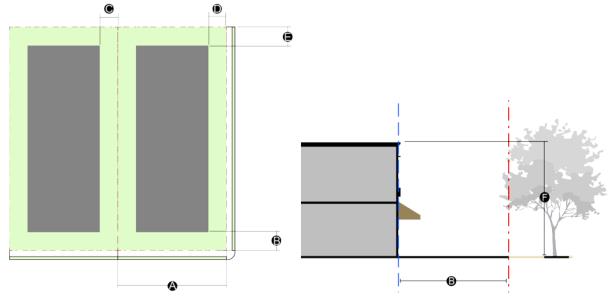
|
Large Commercial |
||
|---|---|---|
|
|
Lot Size |
|
|
A |
Width |
200' min. |
|
|
Area |
50,000 s.f. min. |
|
|
Building Placement |
|
|
B |
Front |
25' min. |
|
C |
Side |
25' min. |
|
D |
Corner Side |
25' min. |
|
E |
Rear |
25' min. |
|
|
Building Scale and Mass |
|
|
F |
Height |
65' max./5 stories |
|
|
Frontage Type |
Buffer Edge; Terrace |
|
|
Building Coverage |
50% max. |
|
|
Design and Performance Standards |
|
|
|
Transparency = 30% min. on street-facing facades. |
|
|
|
Primary Entrance Feature = 1 per building min. required on street frontage. |
|
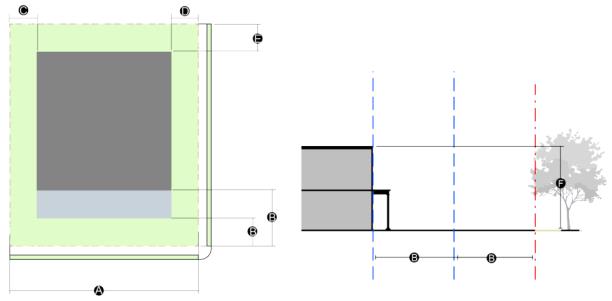
|
Small Civic |
||
|---|---|---|
|
|
Lot Size |
|
|
A |
Width |
50' – 300' |
|
|
Area |
5,000 s.f. – 2.5 ac. |
|
|
Building Placement |
|
|
B |
Front |
20' – 50' |
|
C |
Side |
25' min. |
|
D |
Corner Side |
25' min. |
|
E |
Rear |
25' min. |
|
|
Building Scale and Mass |
|
|
F |
Height |
35' max./2 stories |
|
|
Frontage Type |
Neighborhood Yard; Terrace |
|
|
Building Coverage |
50% max. |
|
|
Design and Performance Standards |
|
|
|
No parking shall be located within 25' of a front lot line or 10' of a side or rear lot line. |
|
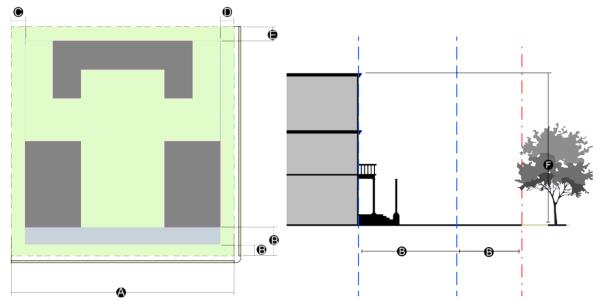
|
Prominent Civic |
||
|---|---|---|
|
|
Lot Size |
|
|
A |
Width |
150' min. |
|
|
Area |
2.5 – 5 acres; larger lot sizes permitted only as part of a campus plan through the planned development process that considers internal access and circulation with surrounding areas. |
|
|
Building Placement |
|
|
B |
Front |
20' – 50' |
|
C |
Side |
25' min. |
|
D |
Corner Side |
25' min. |
|
E |
Rear |
25' min. |
|
|
Building Scale and Mass |
|
|
F |
Height |
55' max./4 stories |
|
|
Frontage Type |
Neighborhood Yard; Terrace |
|
|
Building Coverage |
50% max. |
|
|
Design and Performance Standards |
|
|
|
No parking shall be located within 25' of a front lot line or 10' of a side or rear lot line. |
|
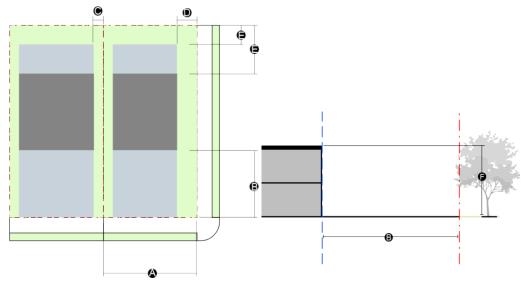
|
Small Industrial/Workshop |
||
|---|---|---|
|
|
Lot Size |
|
|
A |
Width |
40' min. |
|
|
Area |
2,000 s.f. – 10,000 s.f. |
|
|
Building Placement |
|
|
B |
Front |
0' – 25' |
|
C |
Side |
5' min./15' min. if adjacent to residentially zoned parcels |
|
D |
Corner Side |
10' min. |
|
E |
Rear |
25' min./10' min. for alley-loaded lots |
|
|
Building Scale and Mass |
|
|
F |
Height |
35' max./2 stories |
|
|
Frontage Type |
Buffer Edge; Enhanced Streetscape; Terrace |
|
|
Building Coverage |
70% max. |
|
|
Design and Performance Standards |
|
|
|
0' – 10' front setback with Enhanced Streetscape frontage type on a designated Activity street or in the C-1 district; 10' – 25' front setback with the Terrace frontage type and in all other cases. |
|
|
|
Enhanced Streetscape or Terrace frontage type required on Activity street. |
|
|
|
Primary Entrance Feature = 1 per building frontage; at least 15' on each side of the entrance shall have an enhanced facade design with 50% to 80% transparency and architectural ornamentation. |
|
|
|
Parking shall be limited to no more than 12 spaces per site and/or on-street parking; any on-site parking shall be set back at least 15' from the front lot line and at least 5' from side or rear property lines. |
|
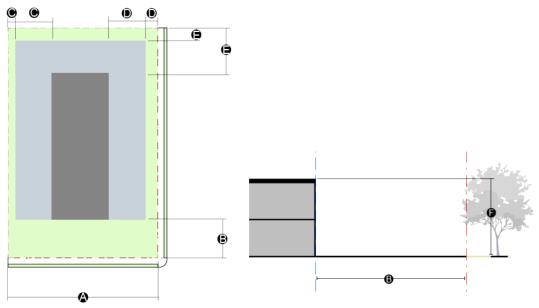
|
General Industrial |
|||
|---|---|---|---|
|
|
Lot Size |
||
|
A |
Width |
100' min. |
|
|
|
Area |
10,000 s.f. min. |
|
|
|
Building Placement |
||
|
B |
Front |
50' min. |
|
|
C |
Side |
10' min./50' min. if adjacent to residentially zoned parcels |
|
|
D |
Corner Side |
20' min./50' min. if across from residentially zoned parcels |
|
|
E |
Rear |
15' min./50' min. if adjacent to residentially zoned parcels |
|
|
|
Building Scale and Mass |
||
|
F |
Height |
75' max./50' max. if adjacent to residentially zoned parcels |
|
|
|
Frontage Type |
Buffer Edge |
|
|
|
Building Coverage |
50% max. |
|
|
|
Design and Performance Standards |
||
|
|
Primary Entry Feature = 1 per building min. required on street frontage. |
||
|
|
Massing = On all street-facing facades, shall break down components of the main mass with single wall planes longer than 100' by using at least one of the following options: |
||
|
|
1. |
Changes in the wall plane involving projections or recesses of at least one foot and extending the full height of the facade every 100' or less of facade length. |
|
|
|
2. |
Varying roof lines or roof forms every 100' or less of facade length. |
|
|
|
Transparency = 15% min. on all street-facing facades. Up to 10% of required transparency can be waived upon substitution of higher quality building materials such as solid brick, stone, detailed concrete, burnished CMU, specialty glass, or architectural panels. |
||
|
|
Articulation = Horizontal and vertical breaks with similar architectural details, materials and colors shall be used on all building facades. Such breaks may include bands of accent color, changes in materials or textures, windows and doors, exposed expansion joints, shadow patterns, expression lines, cornices, and raised parapets. All single-plane changes in color, materials and textures shall be separated or framed by expression lines, trim or similar outlines. |
||
|
|
Ornamentation = Any other blank wall areas larger than eight feet tall by 25' wide shall be broken up by ornamental architectural details, unless the blank surface area is less than 10% of the total facade area and the longest dimension of the blank surface area is less than 50'. |
||
(Ord. 2584 § 1; Ord. 2563 § 1; Ord. 2533 § 1; Ord. 2518 § 2 (LDC § 7.04))
17.07.050 Frontage Design
A. Design Objectives. Frontage Types establish the relationship of the building to the public realm, based upon the context, streetscape design, and the specific buildings and uses permitted on a block. The design standards for the Frontage Types have the following objectives:
1. Create transitions that allow a range of different buildings to engage the streetscape in compatible ways along a block.
2. Enhance the image of the City by coordinating streetscape investment with private lot and building investment.
3. Coordinate development across several lots, considering access, parking, landscape and civic/open space design.
4. Promote higher design amenities in areas intended for more compact and walkable development.
B. Applicability. Each Building Type includes one or more permitted Frontage Types in GMC 17.07.040, to allow each building to best relate to the context. In general, Table 7-4 identifies the permitted and preferred Frontage Types based on the appropriate Street Type from Chapter 17.04 GMC.
|
Table 7-4: Frontage Types and Street Types |
|||||||
|---|---|---|---|---|---|---|---|
|
Street Type |
Enhanced Streetscape |
Plaza |
Courtyard |
Terrace |
Neighborhood Yard |
Suburban Yard |
Buffer Edge |
|
Standard |
|
|
|
■ |
■ |
■ |
■ |
|
Activity |
■ |
■ |
■ |
☐ |
|
|
|
|
Neighborhood |
|
|
☐ |
■ |
■ |
|
|
|
Green |
|
|
|
☐ |
☐ |
☐ |
☐ |
|
|
■ Preferred Type ☐ Limited Type, based on development pattern, street network plan and surrounding context and natural characteristics |
||||||
C. Design Standards. The design standards for each Frontage Type are specified below. They supplement the building and lot standards in this chapter, and other site design standards of this Code. However, effective use of Frontage Types can meet multiple standards.
|
Enhanced Streetscape |
|
|
|
An area along the street frontage that may be common or dedicated to the public as part of the right-of-way standards. It includes pedestrian enhancements beyond those required by the Street Type standards to support buildings fronting directly on the streetscape. The Enhanced Streetscape frontage type shall be designed solely for pedestrian amenities such as walkways, seating areas or landscape to increase the comfort in pedestrian areas. |
||
|
Dimensions |
||
|
10' – 15' OR |
||
|
0' – 10' for sites fronting on a street designed to meet or exceed the pedestrian amenity specifications for an Activity street |
||
|
Access Width Limits |
||
|
20% OR Up to 20' if shared access for alley, midblock or other internal circulation system |
||
|
Required Building Frontage |
||
|
90% if fronting on Activity street; |
||
|
70% all others |
||
|
Design and Performance Standards |
||
|
• |
Buildings shall provide direct pedestrian access to the streetscape or to any Enhanced Streetscape provided on the private lot. |
|
|
• |
One small tree for every 25' or one medium or large shade tree for every 50'; plus ornamental planting in conjunction with the overall streetscape design, particularly at building entrances (street trees planted in the right-of-way per Street Type specifications in Chapter 17.04 GMC may count to this requirement). |
|
|
• |
Outside seating should be provided, either through seating areas associated with the building use or through street furniture or other type of street amenity designed for pedestrian use. |
|
|
• |
Facades fronting on the streetscape should have high permeability with frequent windows and entrances to activate the space. |
|
|
• |
Appropriate for buildings which have a 0' – 10' setback from the street or from any pedestrian-oriented internal access streets. |
|
|
Plaza |
|
|
|
A small area recessed within the building footprint or arranged at a corner of a building establishing a focal point for the building entrance, creating a transition to the streetscape and designed with formal or informal seating or other pedestrian amenities. |
||
|
Dimensions |
||
|
5% to 15% of building footprint |
||
|
At least 10% for any building footprint over 10,000 square feet or building over 3 stories |
||
|
15' – 40' deep |
||
|
20' – 100' wide |
||
|
Access Width Limits |
||
|
20% OR Up to 20' if shared access for alley, mid-block or other internal circulation system |
||
|
Required Building Frontage |
||
|
70% |
||
|
Design and Performance Standards |
||
|
• |
Buildings shall have direct access to the streetscape or Plaza; the Plaza shall have direct pedestrian access to the public sidewalk in the streetscape. |
|
|
• |
One small tree for every 300 s.f.; one medium or large shade tree for every 600 s.f. |
|
|
• |
Allocation of space shall be: 10% – 40% landscape; and 60% – 90% hardscape. |
|
|
• |
Facades fronting on the streetscape should have high permeability with frequent windows and entrances to activate the space. |
|
|
• |
The enclosure ratio (width of space to height of buildings) for buildings on the Plaza should be between 2:1 and 1:2. |
|
|
• |
Appropriate for buildings which have a 0' – 10' setback from the street or from any pedestrian-oriented internal access streets. |
|
|
Courtyard |
|
|
|
A recessed area within the building footprint or an open area organizing multiple buildings that creates a common focal point and point of entry for the building(s) fronting on the Courtyard. The edge along the lot frontage establishes a transition to the public streetscape, and the proportions of the space and building facades create an outdoor room. |
||
|
Dimensions |
||
|
600 s.f min. |
||
|
150 s.f. per dwelling unit for residential; |
||
|
10% – 20% of building(s) footprint for nonresidential |
||
|
20' – 75' width |
||
|
20' – 100' depth |
||
|
Access Width Limits |
||
|
20% OR |
||
|
Up to 20' if shared access for alley, mid-block or other internal circulation system |
||
|
Required Building Frontage |
||
|
50% residential; |
||
|
70% nonresidential |
||
|
Design and Performance Standards |
||
|
• |
Buildings shall have direct access to the streetscape or Courtyard. |
|
|
• |
The Courtyard shall have direct sidewalk connection at least 5' wide between the Courtyard and the public sidewalk. |
|
|
• |
One small tree for every 300 s.f.; OR one medium or large shade tree for every 600 s.f. |
|
|
• |
Allocation of space shall be: 0 – 30% turf; 40% – 75% landscape; and 20% – 40% hardscape. |
|
|
• |
The enclosure ratio (width of space to height of buildings) for buildings on the Courtyard should be between 1:2 and 3:1. |
|
|
• |
Appropriate for buildings which have a 0' – 25' setback from the street. |
|
|
Terrace |
|
|
|
A shallow open area across multiple frontages along a block face, that creates a continuous landscape element along the streetscape. Buildings are set back at a consistent distance to create a common open area. The Terrace can be elevated above the streetscape to create building access closer to grade along blocks with grade changes. The Terrace may be landscaped as a yard, courtyard or garden in more residential settings, or it may include hardscape elements designed as streetscape or a plaza in more compact, walkable settings. |
||
|
Dimensions |
||
|
10' – 25' deep |
||
|
Entire width of lot frontage |
||
|
Access Width Limits |
||
|
20% OR Up to 20' if shared access for alley, mid-block or other internal circulation system |
||
|
Required Building Frontage |
||
|
50% residential; |
||
|
70% nonresidential |
||
|
Design and Performance Standards |
||
|
Residential |
||
|
• |
One small tree for every 25' feet of frontage; OR one medium or large shade tree for every 50' of frontage (street trees planted in the right-of-way per Street Types specification in Chapter 17.04 GMC may count to this requirement). |
|
|
• |
Allocation of space shall be: 0 – 70% turf; 20% – 90% landscape; and 10% – 20% hardscape. |
|
|
• |
All buildings shall have a direct sidewalk connection at least 5' wide between each front entrance and the sidewalk. |
|
|
Nonresidential |
|
|
|
• |
One small tree for every 50' feet of frontage; OR one medium or large shade tree for every 100' of frontage (street trees planted in the right-of-way per Street Type specifications in Chapter 17.04 GMC may count to this requirement). |
|
|
• |
Allocation of space shall be: 0 – 70% turf; 10% – 90% landscape; and 10% – 90% hardscape. |
|
|
• |
Seating areas, either provided in association with the building use/building entrances or as street furniture, should be provided in appropriate focal points. |
|
|
• |
Direct sidewalk connections at least 8' wide to the streetscape shall occur at least every 50'. |
|
|
• |
Appropriate for buildings which have a 10' – 25' setback from the street. |
|
|
Neighborhood Yard |
|
|
|
A small to moderate open area with a building set back from the property line. The Neighborhood Yard generally creates a consistent landscaped area across several frontages along a block face, with buildings set back at a common distance – typically greater than other frontage types – where landscape designs and primary entrance features of buildings establish the relationship and transitions to the streetscape. |
||
|
Depth |
||
|
25' – 35' |
||
|
Access Width Limits |
||
|
15%; 20' max. per access point |
||
|
Required Building Frontage |
||
|
50% |
||
|
Design and Performance Standards |
||
|
• |
One small tree for every 50' feet of frontage; OR one medium or large tree for every 100' of frontage (in addition to required street trees). |
|
|
• |
Allocation of space shall be: 30% – 75% turf; 10% – 50% landscape; and 5% – 20% hardscape. |
|
|
• |
All buildings shall have a direct sidewalk connection at least 4' wide between the sidewalk and the front entry feature. |
|
|
• |
Appropriate for buildings which have a 25' or more setback from the street or from internal access streets. |
|
|
• |
See Chapter 17.08 GMC for general landscape and site design standards. |
|
|
Suburban Yard |
|
|
|
A large open area with a building set back from the property line to create a larger, uninterrupted open area. The Suburban Yard generally creates a large landscaped area across several frontages along a block face, with buildings set back at a common distance – typically greater than other frontage types – where landscape designs rather than building frontages establish the relationship and transitions to the streetscape. |
||
|
Depth |
||
|
25' min. dependent on specific Building Type |
||
|
Access Width Limits |
||
|
30%; 24' max. per access point, applicable to the area within the right-of-way |
||
|
Required Building Frontage |
||
|
N/A |
||
|
Design and Performance Standards |
||
|
• |
One small tree for every 50' feet of frontage; OR one medium or large tree for every 100' of frontage (in addition to required street trees). |
|
|
• |
Allocation of space shall be: 0% – 40% hardscape, with the remainder either landscape or turf. |
|
|
• |
Appropriate for buildings which have a 25' or more setback from the street or from internal access streets. |
|
|
• |
See Chapter 17.08 GMC for general landscape and site design standards. |
|
|
Buffer Edge |
|
|
|
A concentrated and heavily landscaped and/or bermed open area used to separate the site, and any potential impacts of the development and site design, from the streetscape or adjacent lots. |
||
|
Depth |
||
|
20' in A, RE, R-1, and R-2 |
||
|
8' in R-3, R-4, and R-5 |
||
|
12' in C-O, CO-A, C-1, C-2, C-3 and REC |
||
|
20' in M-1 and M-2 |
||
|
Access Width Limits |
||
|
25%; 36' max. for any single access point |
||
|
Required Building Frontage |
||
|
N/A |
||
|
Design and Performance Standards |
||
|
• |
See Chapter 17.08 GMC for general landscape and site design standards. |
|
|
• |
Buffers in GMC 17.08.030 may require greater depth. |
|
|
• |
Appropriate for buildings which have a 25' or more setback from the street. |
|
D. Access Types. Where access is limited to a lot by the standards of any applicable frontage design standard, streetscape design, or the access and parking standards, alternative access design strategies shall be used. Table 7-5, Access Types, demonstrates different configurations for designing adequate vehicle access to individual lots within the parameters of the streetscape design and frontage standards.
|
Table 7-5: Access Types |
|
|---|---|
|
Double Driveway A driveway that is typically between 16' and 20' wide, and provides an approach to a two- or three-car garage with a wider pad and approach area. This access is typically used on larger lots with wide frontages. |
|
|
Single-to-Double Driveway A driveway that is typically between 8' and 10' wide within the lot frontage area, but can expand to a larger pad and approach area up to 24' wide closer to the buildings. This access is used on smaller to medium sized lots with narrower frontages, but can accommodate front or side loaded garages. |
|
|
Single Driveway A driveway that is 8' to 10' at all points before the front building line. It often provides access to a larger pad and approach area behind the front building line to provide access to detached or rear loaded garages. This access is used on smaller lots with narrow frontages, and on streets where minimal interruptions in the streetscape are desired. |
|
|
Shared Driveway A driveway that serves two lots and is typically located on a lot line of the two properties and coordinated with easements, and extends to an area where each lot has its own private pad and/or approach area. Shared driveways usually use the single driveway configurations, and are used on smaller lots with narrow frontages, and on streets were minimal interruptions in the streetscape are desired. |
|
|
Common Driveways An access point similar to a shared driveway except that it serves more than 2 but generally no more than 6 lots. Common driveways are typically located in easements or common areas owned jointly by all lots benefitting from the access. Common driveways can provide access to smaller parking blocks or parking areas where maneuvering of vehicles can occur. |
|
|
Internal Access Streets A system of internal access designed to mimic public streetscapes and block structure. This access coordinates development and access across multiple or larger-scale projects, typically on sites or parcels of greater than 5 acres, so the resulting internal block structure includes blocks of 2 to 5 acres. The internal access streets have a higher design amenity than other access types to create a “public realm” among private and common areas as an organizing element of sites and buildings. |
|
(Ord. 2533 § 1; Ord. 2518 § 2 (LDC § 7.05))



